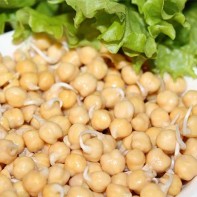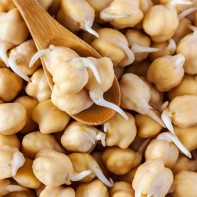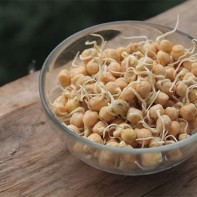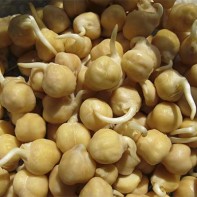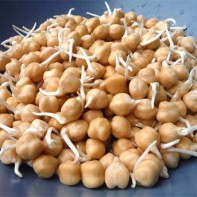Sprouted legume crops have an important place in a healthy diet. Sprouted grain has completely different characteristics than the dried product. At the same time, its benefits increase several times, and the sphere of application is no less than that of traditional types. Sprouted chickpeas are used for culinary and medicinal purposes. In different countries it is called chickpeas or mutton chickpeas.
Composition and Calories
Legumes have a rich composition, but are considered quite heavy to digest. Enzyme inhibitors are to blame. They prevent the seeds from sprouting early, and in the human body they cause flatulence and bloating if consumed in large quantities. But at the moment of germination, when the sprout does not exceed 2-3 mm, protective mechanisms are already turned off, and the useful properties are increased. At the same time, the digestibility also becomes much higher, and the side effects almost disappear. In the composition:
- potassium;
- calcium;
- phosphorus;
- bromine;
- magnesium;
- chlorine;
- sodium;
- selenium;
- Zinc;
- copper;
- iron;
- cobalt;
- Vitamins C, PP, K, B group;
- retinol;
- choline;
- amino acids.
The high protein content makes it possible to partially replace mutton peas with meat. At the same time, the feeling of satiety is maintained for a long time, so the product is often included in programs for weight correction.
The benefits of sprouted chickpeas
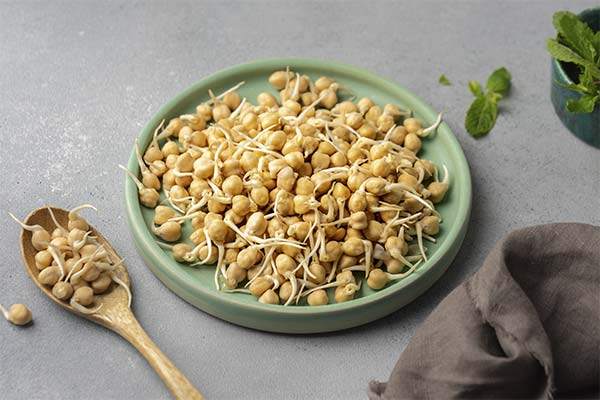
Regular inclusion of chickpeas in sprouted form in the menu, has a positive effect on health. Chickpeas help to normalize metabolism, strengthen the cardiovascular system, prevent the development of osteoporosis, improving the absorption of calcium and preventing its leaching from the body. Given the low glycemic index and features of the product itself, which is assimilated to the maximum level, it can and should be included in the diet for diabetes to make up for the deficiency of useful substances.
Mutton pea sprouts bind and eliminate free radicals, the abundance of fiber acts like a sponge, cleansing and stimulating intestinal peristalsis.
Increases the elasticity of blood vessels, cleanses the walls, increases the lumen, which serves as an excellent prevention of strokes and heart attacks. Increases the stability of the heart muscle, removes excess bile, eliminates fluid stagnation.
The product is recommended for inclusion on menus in weight control and correction programs. Quickly quenching the appetite with a small amount, sprouts give a powerful burst of energy, increase tone, speed up metabolism and stabilize the emotional state.
Sprouted chickpeas are especially useful for men who are physically demanding. It also works as an aphrodisiac and stimulates libido, and helps athletes maintain muscle growth due to its high protein content. For women, sprouted legumes are desirable to introduce into the diet at any age, including the menopausal period.
Sprouts are also used externally. Ointment based on chickpea flour is effective against burns, irritations, various skin diseases. In cosmetology, adding chickpea sprouts to masks increases their nutritional value, making the skin well-groomed and velvety.
Harms and restrictions on use
It is true of any product that everything must be in moderation. So, the daily recommended rate for legume sprouts is from 50 to 100 grams. The truest guide is how you feel. For each person, the amount is likely to be different. For those who like the taste, you can eat more, but keep in mind that beans, even sprouted, are quite heavy food and can provoke increased gas.
An absolute contraindication to use is an individual intolerance to the product. Limit the amount or temporarily give up chickpeas will have to, if there is a history of:
- thrombophlebitis;
- Bladder disease;
- Risk of developing cholelithiasis;
- Gout;
- exacerbation of gastrointestinal diseases;
- Problems with the circulatory system.
How to sprout chickpeas at home
Buying such a product is not worth it. First, it is sold only in specialized stores, secondly, it is much more expensive than dry beans, and thirdly, the quality is not guaranteed, especially when you consider that the sprouted chickpeas are stored for only 2-3 days.
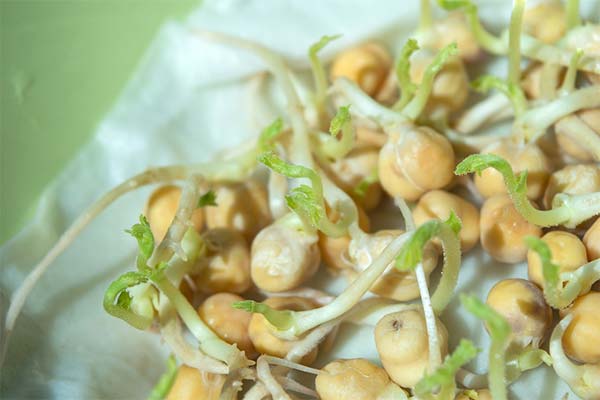
There is nothing complicated about the process of sprouting your own chickpeas:
- Pick, remove spoiled and splintered seeds.
- Rinse thoroughly 2 to 3 times.
- Place in a glass container at the rate that the chickpeas take up 1/4 of the jar.
- Pour water at room temperature, cover the neck with foil, film, parchment paper, making a few holes in it for the beans to breathe.
- After 4 hours, drain the resulting liquid and pour fresh water, covering the container from above with gauze or cotton cloth.
After 12-18 hours, sprouts will appear. Once they reach a size of 2-3 mm, this is optimal. The water is drained, the sprouted beans are slightly dried on a napkin and put in the refrigerator. Store in a closed container, the shelf life of the product is 5 days. It is better to calculate portions so that eat them in 2-3 days, by this time having prepared a new series.
Sprouts are used in many different ways. They are eaten with a little honey as breakfast, ground into flour and baked cakes, added to soups, main courses and salads. The healthiest product is without heat treatment.
“Important: All information on this site is provided for informational purposes only.
for informational purposes only.
Please consult with a health care professional before using any of the recommendations.
specialist before applying any of the recommendations.
Neither the editors nor the authors are responsible for any possible harm caused by
materials.”
Photo of sprouted chickpeas
